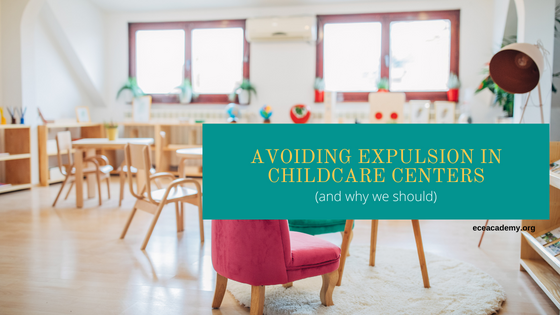Avoiding Expulsion in Childcare Centers (and why we should)
“Sorry, they’re just not a good fit for this environment.”
In recent years nearly 48% of parents and caregivers have heard some variation of this phrase because their child is being expelled from their daycare/preschool.
And the number continues to grow at an alarming rate.
While we completely understand the sentiment of teachers and childcare owners saving their peace, as stewards of these children during their most impactful foundational years, it’s crucial we fully understand the impact of expulsion practices on children and why we should, to the best of our ability, avoid it.
It might sound dramatic, but the research is clear- expulsion from daycare/childcare can jumpstart a child’s negative trajectory throughout their education.
Our ability to intervene in their early years can make all the difference in the child’s future.
What the data says:
Students who are expelled or suspended are as much as 10 times more likely to drop out of high school, experience academic failure, hold negative school attitudes, and face incarceration than those who are not.
Expulsion or suspension early in a child’s education predicts expulsion or suspension in later school grades.
Furthermore, data consistently show racial disparities in expulsion and suspension. For example, recent data indicate that African American boys make up 18% of preschool expulsions.
Young children in PreK programs are expelled at almost 3x the number of children in K-12 and children in childcare programs almost 13x more.
And being kicked out of school is also emotionally and mentally difficult, as well as disorienting for the child and their family, adding on a new layer of stress that will likely only further exacerbate their behavior for the next classroom that receives them.
There’s a very high likelihood that your own center is enrolling children who have been expelled from their previous center, leaving you and your staff with the unconscious, negative emotional aftermath of that experience.
It’s an unhealthy cycle of bouncing a young child from one childcare to another, with few willing to take the opportunity to dig deeper and see if more can be done.
And those who are expelled at the highest rate, are often the children who would actually benefit the most from early childhood education.
So, why is this happening?
The most common reason cited for expelling a child from a center is aggressive behavior (hitting, kicking, biting, etc).
This is objectively a challenging behavior to have to confront in a child, especially if other children in the classroom are being targeted.
However, another study also shows that when centers have the help and support of a behavioral health specialist those centers expel at half the rate of those who didn’t.
Likewise, centers with high-quality, trained staff are also less likely to expel a child than those with under trained staff.
So it’s safe to conclude, it might not be children’s behavior, but in our knowledge and skill as adults to manage these behaviors.
When you empower your staff and equip them with the necessary skill, training, and support they need to handle challenging behavior you reduce the need to expel children.
There’s also research supporting that teachers would like to grow their skills in behavior management.
“A multi-year SRI evaluation of state-wide preschool programs found that a majority of teachers wanted more program development on supporting children that show challenging behaviors, including key areas like preventing and stopping aggressive behavior and practical and effective solutions to disruptive behaviors.”
Teachers who have been trained are more willing to tackle the behavior as well.
What can we do to reduce/eliminate expulsions in ECE?
Strong onboarding process
Ongoing Professional Development and training
Reflective supervision and collaborative performance assessments
Training on a myriad of topics including neurodiversity and trauma-informed care
The more skill and resources they have to handle challenging behaviors, the more confident they are dealing with this in their classrooms.
Take care of staff:
There is a strong correlation between teacher stress and expulsions. Centers, where teachers expressed high levels of stress or unhappiness, were more likely to expel children.
Implement center policies that help prevent expulsion:
Reduced classroom size and ratios to give staff ample opportunity to individually support children and reduce stress
Ensure veteran and new staff understand why the site doesn’t expel children (or severely limits it) and alternatives from the first day of employment
Require extensive documentation that shows an ongoing attempt to support the child and all available alternatives have been exhausted prior to considering expulsion
Encourage parental support
Partnerships with state programs and other programs to make resources such as behavior and speech screenings, food/housing support, therapeutic services, and more available for children.
Encourage best practices and developmentally appropriate expectations.
Tackling Implicit bias:
Professional Development and training on the impact of implicit biases
Reflective conversations with an ECE coach or center director/mentor
Encouraging staff to understand and learn more about individual students’ and co-workers' cultural backgrounds.
Seek out outside support:
As we saw earlier, when behavior support is available, we see a reduction in expulsions and a reduction in challenging behavior.
>Seek out support for the staff like technical assistance and mental health consultants.
>Seek out support for yourself as a leader such as coaching, director/owner cohorts, or conferences so you can continue to guide and support your staff.
>And seek out support for the child such as therapeutic services, evaluations, and partnerships with local school services. Some can even meet and provide services at the center.
What if I do have to expel a child?
So you’ve exhausted all possible avenues of support but unfortunately there just doesn’t seem to be much else you or your teachers can do.
This could be for a myriad of reasons such as a child causing a severe injury to a child or staff member or needing extensive services beyond what your center can provide.
Be open and honest with the child's caregiver. Hopefully, you’ve already been in continuous communication with the caregiver so they won’t be blindsided by the decision. Review the attempts made, the progress and lack of progress, and what made you come to the conclusion to term the child.
Give them a date and time to plan. It would reflect poorly on your business to give a caregiver notice the next day they drop off that they can’t bring their child anymore. Give them a solid date ahead of time so they can make other arrangements.
Offer support and resources. Some parents/caregivers may be more receptive to this than others, depending on the circumstances, but if possible, offer assistance during the transition.
Maybe you know a center that would be better equipped for the child, the contact information of the company that does free evaluations, or the local school’s resource page. Allow them to take a copy of the behavior plan for the next educator to see the progress and attempts made.
Overall, you want the child and the parent/caregiver to know that you still care about the child, want to see them be successful, and don’t view them as just another “trouble” to be tossed to the next daycare.
If you found this blog post helpful, feel free to share it with peers or open discussion about it in our free Facebook community The Early Childhood Lounge.






Aggressive behavior like hitting, kicking, and biting are easily cited as one of the most stressful behaviors in the early childhood classroom. Here are some tips for handling aggressive behavior in the PreK/daycare classroom.